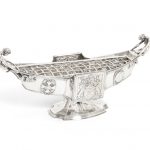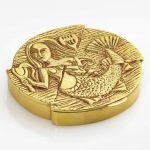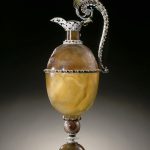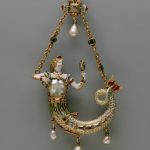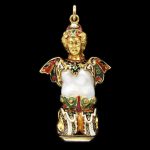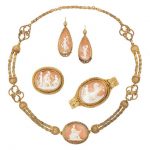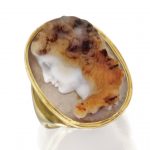Information on mermaids in cameos and other art. Mermaids are usually depicted as half human and half fish. They have been popular in many forms of art, including cameos, for many years.
Depictions of entities with the tails of fish, but upper bodies of human beings appear in Mesopotamian artwork from the Old Babylonian Period onwards. These figures are usually mermen, but mermaids do occasionally appear. The name for the mermaid figure may have been kuliltu, meaning “fish-woman”. Such figures were used in Neo-Assyrian art as protective figures and were shown in both monumental sculpture and in small, protective figurines.
The first known mermaid stories appeared in Assyria c. 1000 BC. The goddess Atargatis, mother of Assyrian queen Semiramis, loved a mortal (a shepherd) and unintentionally killed him. Ashamed, she jumped into a lake and took the form of a fish, but the waters would not conceal her divine beauty. Thereafter, she took the form of a mermaid — human above the waist, fish below — although the earliest representations of Atargatis showed her as a fish with a human head and arm, similar to the Babylonian god Ea. The Greeks recognized Atargatis under the name Derketo. Sometime before 546 BC, Milesian philosopher Anaximander postulated that mankind had sprung from an aquatic animal species. He thought that humans, who begin life with prolonged infancy, could not have survived otherwise.
An Arts & Crafts silver centrepiece by Omar Ramsden, London 1934 / 1935 Shaped-oblong form with central projections featuring the arms of Baron Hyndley of Meads, Sussex, at each end a mermaid on rope support, with a removable flower grille, the body with applied insignia for a Knight Bachelor, a Baronet, a knighthood of the Order of the Crown of Italy and the 1935 jubilee medal for George V, accompanied by a photo and a signed note from Omar Ramsden to Lord Hyndley, length 44.5cm, weight 87oz.
Sold for £ 8,750 inc. premium at Bonhams in 2018
LINE VAUTRIN (1913-1997) SIRÈNE
Poudrier in gilt bronze, around 1945 Thickness: 1 cm. (3/8 in.); Width: 6.7 cm. (25/8 in.); Depth: 6 cm. (2 3/8 in.) Stamped LINE VAUTRIN
Sold for £8,750 inc. premium at Christies in
Gold, Carved Coral Mermaid and Diamond Brooch 14 kt., carved coral ap. 23.0 x 47.5 mm., ap. 17.5 dwt.
Carved coral: light orange to mostly medium orange, nice carving, medium luster. Diamonds: J-K-VS. Good condition. 1 5/16 x 2 1/4″.
Sold for $1,152 (includes buyer’s premium) at Doyle New York in 2011
Mettlach Cameo 13″ Vase Mermaids & Dolphins
Two different mermaid and dolphin scenes. Mint.
Sold for $220 at
This ewer came into the collection of Louis XIV some time between 1681 and 1684. Jean Vangrol, a goldsmith of Flemish origin who lived in Paris, probably made the mounting in about 1640. This piece is typical of Parisian works dating from the 1640s and 1650s in the Crown collection of gems and gemstone vases. The name of the stone carver is not recorded, but Vangrol’s mounting in enamelled gold is proof of the remarkable skill of Parisian goldsmiths in the 17th century.
The agate ewer This egg-shaped ewer consists of six pieces of predominantly yellow agate: the neck, an upside-down bowl, a second bowl with a small molded foot, a sphere used as a baluster, a small ring, and a third small bowl used as the base since 1941 in place of the original foot, which may have been lost in 1830. The two bowls that form the egg-shaped body of the ewer are decorated with carvings by an unknown master who signed the work with the initials WFS. The same artist also carved similar scenes on the rock crystal vase MR 321.
The engraved decoration The decoration carved in the agate is in two parts, both developing themes, inspired by the sea, that are normally only found on rock crystal pieces. The upper bowl depicts a circular building on a rock, a dolphin, and a sea monster guarding the collar of the Golden Fleece and a large sailing ship. The lower bowl depicts a mermaid preparing to give a palm leaf trophy and a crown to a second mermaid who is blowing a horn, two dolphins – the second with a cherub on its back – and four large palmettes of torn leaves and seeds in the same style as the leaves on the mounting. This shows that the carving on the ewer was carried out at the same time as the mounting was made. The identity of the lapidary, or stone carver, remains a mystery. He signed his work with the initials WFS and may have been Flemish, like the goldsmith Jean Vangrol, or possibly German.
Reference:The Louvre
Platter, opalescent glass, ‘Calypso’, with nymph figures, René Lalique et Cie, Wengen-sur-Moder, France, c. 1930 Made in France, Europe, c 1912.
The platter dates from around 1930, and is representative of Lalique’s designs in the art deco style incorporating naked female forms. René Lalique (1860-1945) was one of the world’s foremost designers and manufacturers of glass objects from the late nineteenth century through to the late 1930s. He successfully combined techniques of mass production with high artistic standards. His designs embraced the styles of both Art Nouveau and Art Deco. Before he began manufacturing in glass, Lalique was internationally celebrated as an innovative designer and maker of fine jewellery in the Art Nouveau style.
Reference: Museum of Applied Art and Sciences
Pendant in the form of a mermaid Designer:Probably based on a design by Reinhold Vasters (German, Erkelenz 1827–1909 Aachen) Date:ca. 1870–95
A number of details of the design of this jewel—including the long, attenuated fish tail, the wispy, featherlike skirt, the stole draped from the shoulders, and the hair styled in a low chignon worn with a tiara—are present in two unpublished designs for a mermaid jewel by the Aachen goldsmith Reinhold Vasters that are now in the Victoria and Albert Museum, London. The techniques employed in finishing the enameled gold tail indicate that the goldsmith who executed the jewel misunderstood certain Renaissance practices in preparing gold to receive enamel and in smoothing and polishing the surface once the enamel has been fired, misunderstandings that may have arisen, at least in part, from looking at worn or damaged sixteenth-century jewels.
Reference: The Metropolitan Museum of Art
‘Sirène’ fruit bowl French model designed 1920 René Lalique (French, 1860–1945)
Shallow bowl of frosted and pressed glass with mermaid decoration (visible from front, relief on back) and three low feet.
Reference: Museum of Fine Arts Boston
A monumental Austrian gilt-metal and enamel nef, Vienna, late 19th century the base on four dolphin-headed supports, the hull supported by a mermaid, the interior with an engraved panel of Neptune, the detachable deck with numerous sailors, including drinkers, musicians, and card players, the three masts with sails and pennants enameled on both sides with classical and romantic scenes height 48 1/2 in., length 26 1/2 in. 123 cm, 67.4 cm
Sold for 62,500 USD at Sothebys in 2017
This pendant made in the nineteenth century in the Renaissance Revival style has a lapis lazuli base intended to be engraved with an intaglio like a seal, but in fact the stone was uncut, and the pendant remains purely decorative. The figure of the mermaid is formed around a large baroque pearl, like some Renaissance pendants made during the sixteenth century which were much admired by the artist goldsmiths and the collectors of the nineteenth century. Renaissance pendants were appreciated as small-scale sculptures which displayed the arts of the modeller, chaser, enameller and jeweller. The greatest compliment that could be paid to a goldsmith in the middle of the 19th century was to compare him to the celebrated Florentine sculptor and goldsmith Benvenuto Cellini
Reference: © Victoria and Albert Museum
A large aquamarine, with its table engraved to show a bell and a compass, is set in a gold ring. The shoulders are in the form of mermaids holding anchors whose tails intertwine to complete the shank. Large fish accompany the mermaids. The ring was shown at the World’s Columbian Exposition in Chicago in 1893 and then bought by Henry Walters, an enthusiastic yachtsman.
Tiffany & Company
Reference: The Walter Art Museum
